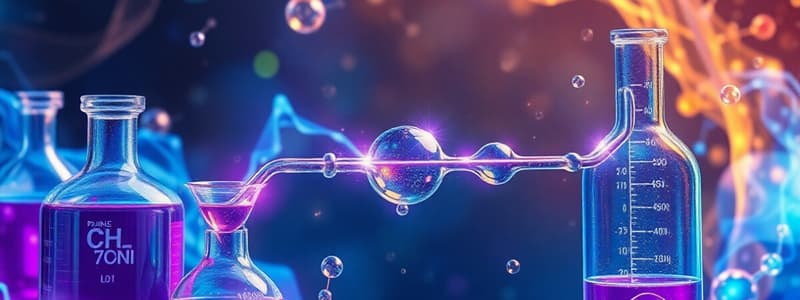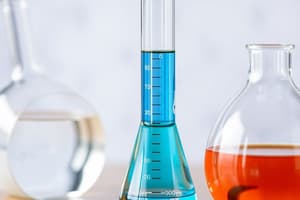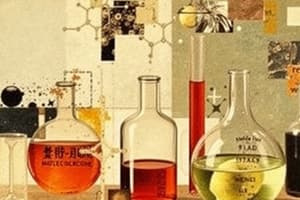Podcast
Questions and Answers
What characterizes a decomposition reaction?
What characterizes a decomposition reaction?
- A complex substance breaks down into simpler substances. (correct)
- A substance combines to form a more complex compound.
- Two compounds create a new compound by exchanging parts.
- A single uncombined element displaces an element in a compound.
In which reaction does the general form A + BC ⟶ AC + B apply?
In which reaction does the general form A + BC ⟶ AC + B apply?
- Synthesis reaction
- Single replacement reaction (correct)
- Decomposition reaction
- Double replacement reaction
What is produced in the reaction Mg + 2 H2O ⟶ Mg(OH)2 + H2↑?
What is produced in the reaction Mg + 2 H2O ⟶ Mg(OH)2 + H2↑?
- Magnesium and oxygen gas
- Ammonium hydroxide and hydrogen gas
- Water and potassium hydroxide
- Magnesium hydroxide and hydrogen gas (correct)
Which option represents a double replacement reaction?
Which option represents a double replacement reaction?
What does the formation of water when metallic hydroxide reacts with an acid illustrate?
What does the formation of water when metallic hydroxide reacts with an acid illustrate?
Which of the following substances is expected to act as a strong electrolyte when dissolved in water?
Which of the following substances is expected to act as a strong electrolyte when dissolved in water?
Which of the following compounds would produce a non-electrolyte solution in water?
Which of the following compounds would produce a non-electrolyte solution in water?
Which type of chemical reaction involves the combination of two or more reactants to form a single product?
Which type of chemical reaction involves the combination of two or more reactants to form a single product?
Which of the following substances is a weak acid when dissolved in water?
Which of the following substances is a weak acid when dissolved in water?
In the reaction represented as $A + B ⟶ AB$, which type of reaction is being described?
In the reaction represented as $A + B ⟶ AB$, which type of reaction is being described?
What is the primary purpose of stoichiometry in chemical reactions?
What is the primary purpose of stoichiometry in chemical reactions?
In the balanced equation 2 C8H18 + 25 O2 → 16 CO2 + 18 H2O, how many moles of O2 are needed to completely react with 10 moles of C8H18?
In the balanced equation 2 C8H18 + 25 O2 → 16 CO2 + 18 H2O, how many moles of O2 are needed to completely react with 10 moles of C8H18?
When calculating the amount of CO2 produced from burning 10 moles of C8H18, which conversion factor would you use?
When calculating the amount of CO2 produced from burning 10 moles of C8H18, which conversion factor would you use?
What describes a concentrated solution?
What describes a concentrated solution?
In the example of sugar dissolved in water, what is the solvent?
In the example of sugar dissolved in water, what is the solvent?
Flashcards
Stoichiometry
Stoichiometry
Calculations of reactant and product quantities in a chemical reaction based on balanced equations.
Balanced Chemical Equation
Balanced Chemical Equation
A chemical equation where the number of atoms of each element is the same on both sides of the equation.
Conversion Factor
Conversion Factor
A ratio derived from the coefficients of a balanced chemical equation, used to relate amounts of reactants and products.
Solution
Solution
Signup and view all the flashcards
Concentration of Solution
Concentration of Solution
Signup and view all the flashcards
Synthesis Reaction
Synthesis Reaction
Signup and view all the flashcards
Electrolyte
Electrolyte
Signup and view all the flashcards
Strong Electrolyte
Strong Electrolyte
Signup and view all the flashcards
Weak Electrolyte
Weak Electrolyte
Signup and view all the flashcards
Nonelectrolyte
Nonelectrolyte
Signup and view all the flashcards
Decomposition Reaction
Decomposition Reaction
Signup and view all the flashcards
Electrolysis of Water
Electrolysis of Water
Signup and view all the flashcards
Single Replacement Reaction
Single Replacement Reaction
Signup and view all the flashcards
Double Replacement Reaction
Double Replacement Reaction
Signup and view all the flashcards
Types of Chemical Reactions
Types of Chemical Reactions
Signup and view all the flashcards
Study Notes
General Chemistry for Pharmaceutical Sciences (PHARM-101)
- Course presented by Dr. Azza H. Rageh, Associate Professor of Pharmaceutical Analytical Chemistry at Taibah University.
Stoichiometry, Solution Concentration and Chemical Reactions
- Stoichiometry is the calculation of reactant and product quantities in a chemical reaction.
- Stoichiometry can predict the products' quantities based on reactants' amounts.
- Stoichiometry can determine the necessary reactants to produce a desired product amount.
- Coefficients in a balanced chemical equation define relative amounts (in moles) of substances involved.
Reaction Stoichiometry
- Example: 2 C₈H₁₈ + 25 O₂ → 16 CO₂ + 18 H₂O
- 2 molecules of C₈H₁₈ react with 25 molecules of O₂ to form 16 molecules of CO₂ and 18 molecules of H₂O.
- Alternatively, 2 moles of C₈H₁₈ react with 25 moles of O₂ to form 16 moles of CO₂ and 18 moles of H₂O.
- Stoichiometric Ratio: The ratio of moles between components in a balanced equation (e.g., 2 mol C₈H₁₈ : 16 mol CO₂).
Concentration of Solutions
- Concentration: the amount of solute present in a solution.
- Units: percent weight (% w/w), percent volume (% v/v), percent weight per volume (% w/v), parts per million (ppm), parts per billion (ppb), molarity (M), formality (F), normality (N), and molality (m).
- Definitions:
- Solvent: the component present in the largest amount.
- Solute: the other components.
- Solution: a homogeneous mixture.
Molarity
- Molarity (M): moles of solute per liter of solution.
- Formula: M = moles of solute / Liters of solution
- Unit: mol/L or mol⋅L⁻¹ or molar
Types of Aqueous Solutions and Solubility
- Salt water: homogeneous mixture of NaCl and H₂O.
- Sugar water: homogeneous mixture of C₁₂H₂₂O₁₁ and H₂O.
- Solids dissolve in water due to attractive forces between solute and solvent particles.
What Happens When a Solute Dissolves?
- Solute particles attract each other. Solvent molecules attract each other.
- When mixing solute and solvent, attractive forces occur between solute and solvent particles.
- Strong attractions lead to successful dissolution.
Dissolution of Sodium Chloride in Water
- Ionic compounds (like salt) in water dissociate into ions.
- Water molecules pull the ions off the crystal.
Dissolving of Sugar in Water
- Sugar molecules mix homogeneously with water molecules.
- Sugar doesn't dissociate into ions in water.
- Solutions of sugar do not conduct electricity.
Electrolytes and Nonelectrolytes
- Electrolytes: substances that dissolve in water to create solutions conducting electricity.
- Strong electrolytes completely ionize in water, conduct electricity strongly (e.g., soluble ionic salts, strong acids, strong bases).
- Weak electrolytes partially ionize in water, conduct electricity weakly (e.g., weak acids, weak bases).
- Nonelectrolytes don't ionize in water, don't conduct electricity (e.g., molecular substances, like sugar and alcohol).
Basic Types of Chemical Reactions
- Synthesis reaction: two or more reactants combine to form one product (A + B → AB).
- Decomposition reaction: a more complex substance breaks down into simpler parts (AB → A + B).
- Replacement reaction:
- Single replacement: one element replaces another in a compound (A + BC → AC + B).
- Double replacement: anions and cations of two compounds switch places (AB + CD → AD + CB).
Chemical Reactions between Ions
- Ions form water, weak electrolytes, precipitates, gases, or complex ions.
Formation of Water
- Reaction between metallic hydroxide (including ammonium hydroxide) and an acid; produces water.
Formation of Weak Electrolyte
- Reaction between strong acid and salt containing weak acid anion; yields weak acid.
- Reaction between strong base and ammonium salt; produces weak base (ammonia hydroxide).
Formation of a Precipitate
- Precipitation: formation of a solid in a solution during a chemical reaction.
- Occurs when dissolved ions exceed solubility limit, forming insoluble salt.
- Can be accelerated by adding a precipitating agent or removing solvent.
Formation of a Gas
- Ions may produce gas evolution when the product is gaseous or product is unstable and decomposes to form a gas.
Formation of Complex Ions
- Complexation reaction: a reaction between a Lewis acid (electron acceptor) and a Lewis base (electron donor).
- Ligands bond with a metal atom to form a complex.
Reactions Involving Oxidation-Reduction (Redox)
- Redox reactions involve electron transfer.
- Oxidation: loss of electrons.
- Reduction: gain of electrons.
- Other common redox reactions include rusting of iron, combustion of octane, and combustion of hydrogen.
Oxidizing and Reducing Agents
- Oxidizing agent (oxidant): substance causing oxidation of another; itself is reduced.
- Reducing agent (reductant): substance causing reduction of another; itself is oxidized.
Studying That Suits You
Use AI to generate personalized quizzes and flashcards to suit your learning preferences.




